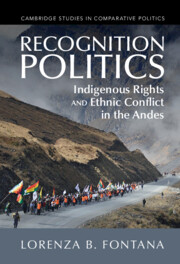130 results
4 - Prior Consultation in Latin American Extractives
- from Part I - Geographies of Environmental Violence
-
-
- Book:
- Exploring Environmental Violence
- Print publication:
- 30 June 2024, pp 84-105
-
- Chapter
-
- You have access
- Open access
- HTML
- Export citation
On Their Own Terms: How Cocalera Organizing Expanded Indigenous Women’s Rights in Bolivia
-
- Journal:
- Latin American Research Review ,
- Published online by Cambridge University Press:
- 25 March 2024, pp. 1-18
-
- Article
-
- You have access
- Open access
- HTML
- Export citation
When Does Lethal Repression Fail? Unarmed Militancy and Backfire in Bolivia, 1982–2021
-
- Journal:
- Journal of Latin American Studies / Volume 56 / Issue 1 / February 2024
- Published online by Cambridge University Press:
- 04 April 2024, pp. 1-36
- Print publication:
- February 2024
-
- Article
-
- You have access
- Open access
- HTML
- Export citation
An introductory framework for ‘Habilito: Debt for Life’
-
- Journal:
- Finance and Society / Volume 2 / Issue 1 / 2016
- Published online by Cambridge University Press:
- 05 January 2024, pp. 86-89
-
- Article
-
- You have access
- Open access
- Export citation
Narratives of Authoritarianism in Times of Crisis: Democracy and Limitations of Progressive Politics in Plurinational Bolivia
-
- Journal:
- Journal of Latin American Studies / Volume 56 / Issue 1 / February 2024
- Published online by Cambridge University Press:
- 15 December 2023, pp. 91-114
- Print publication:
- February 2024
-
- Article
-
- You have access
- Open access
- HTML
- Export citation
Guangyuanite, Pb3Cl3(Se4+O3)(OH), a new lead chloride selenite mineral from the El Dragón mine, Potosí, Bolivia
-
- Journal:
- Mineralogical Magazine / Volume 88 / Issue 1 / February 2024
- Published online by Cambridge University Press:
- 07 December 2023, pp. 97-104
-
- Article
- Export citation
A Possible Case of Coccidioides Infection in a Thirteenth-Century Bolivian Mummy
-
- Journal:
- Latin American Antiquity , First View
- Published online by Cambridge University Press:
- 17 August 2023, pp. 1-8
-
- Article
-
- You have access
- Open access
- HTML
- Export citation
Market Participation of Small-Scale Rice Farmers in Eastern Bolivia
-
- Journal:
- Journal of Agricultural and Applied Economics / Volume 55 / Issue 3 / August 2023
- Published online by Cambridge University Press:
- 03 August 2023, pp. 471-491
-
- Article
-
- You have access
- Open access
- HTML
- Export citation
Going over the wall: insights into the illegal production of jaguar products in a Bolivian prison
-
- Article
-
- You have access
- Open access
- HTML
- Export citation
Indigenous resistance at the frontiers of accumulation: Challenging the coloniality of space in International Relations
-
- Journal:
- Review of International Studies , First View
- Published online by Cambridge University Press:
- 19 June 2023, pp. 1-20
-
- Article
-
- You have access
- Open access
- HTML
- Export citation
Seventeen - The Law of the Excluded: Indigenous Justice and Plurinationality in Bolivia and Ecuador
- from Part Five - Real Legal Utopias: Interrupting the Law
-
- Book:
- Law and the Epistemologies of the South
- Published online:
- 07 August 2023
- Print publication:
- 01 June 2023, pp 503-530
-
- Chapter
- Export citation
Thirteen - The Refoundation of the State in Bolivia and Ecuador?
- from Part Four - Real Legal Utopias: Interrupting the State
-
- Book:
- Law and the Epistemologies of the South
- Published online:
- 07 August 2023
- Print publication:
- 01 June 2023, pp 363-408
-
- Chapter
- Export citation
8 - Populist Discontents, 2002–2021
-
- Book:
- The Nationalist Dilemma
- Published online:
- 25 April 2023
- Print publication:
- 11 May 2023, pp 268-322
-
- Chapter
- Export citation
Bernardevansite, Al2(Se4+O3)3⋅6H2O, dimorphous with alfredopetrovite and the Al-analogue of mandarinoite, from the El Dragón mine, Potosí, Bolivia
-
- Journal:
- Mineralogical Magazine / Volume 87 / Issue 3 / June 2023
- Published online by Cambridge University Press:
- 25 January 2023, pp. 407-414
-
- Article
-
- You have access
- Open access
- HTML
- Export citation

Recognition Politics
- Indigenous Rights and Ethnic Conflict in the Andes
-
- Published online:
- 05 January 2023
- Print publication:
- 05 January 2023
The impact of university reputation on employment opportunities: Experimental evidence from Bolivia
-
- Journal:
- The Economic and Labour Relations Review / Volume 31 / Issue 4 / December 2020
- Published online by Cambridge University Press:
- 01 January 2023, pp. 524-542
-
- Article
-
- You have access
- Open access
- HTML
- Export citation
A review of the humaneness of puntilla as a slaughter method
-
- Journal:
- Animal Welfare / Volume 21 / Issue S2 / June 2012
- Published online by Cambridge University Press:
- 01 January 2023, pp. 3-8
-
- Article
- Export citation
13 - Citizen Insecurity
- from Part II - Current Issues
-
- Book:
- U.S. and Latin American Relations
- Published online:
- 08 December 2022
- Print publication:
- 01 December 2022, pp 356-387
-
- Chapter
- Export citation
5 - The Early Cold War Period
- from Part I - Historical Background
-
- Book:
- U.S. and Latin American Relations
- Published online:
- 08 December 2022
- Print publication:
- 01 December 2022, pp 110-139
-
- Chapter
- Export citation
6 - Opposition Strategies Elsewhere
-
- Book:
- Resisting Backsliding
- Published online:
- 10 November 2022
- Print publication:
- 03 November 2022, pp 178-236
-
- Chapter
- Export citation





